Uncover the intricacies of Mystery snail reproduction and egg hatching in this comprehensive guide. From the peculiar appearance of their egg clutches to the various options for handling them, this article examines the responsibilities and choices faced by aquarists when confronted with a clutch of Mystery snail eggs. With insights into fertilization, hatching methods, and caring for the hatchlings, I will guide you through the process with practical advice and personal experiences.
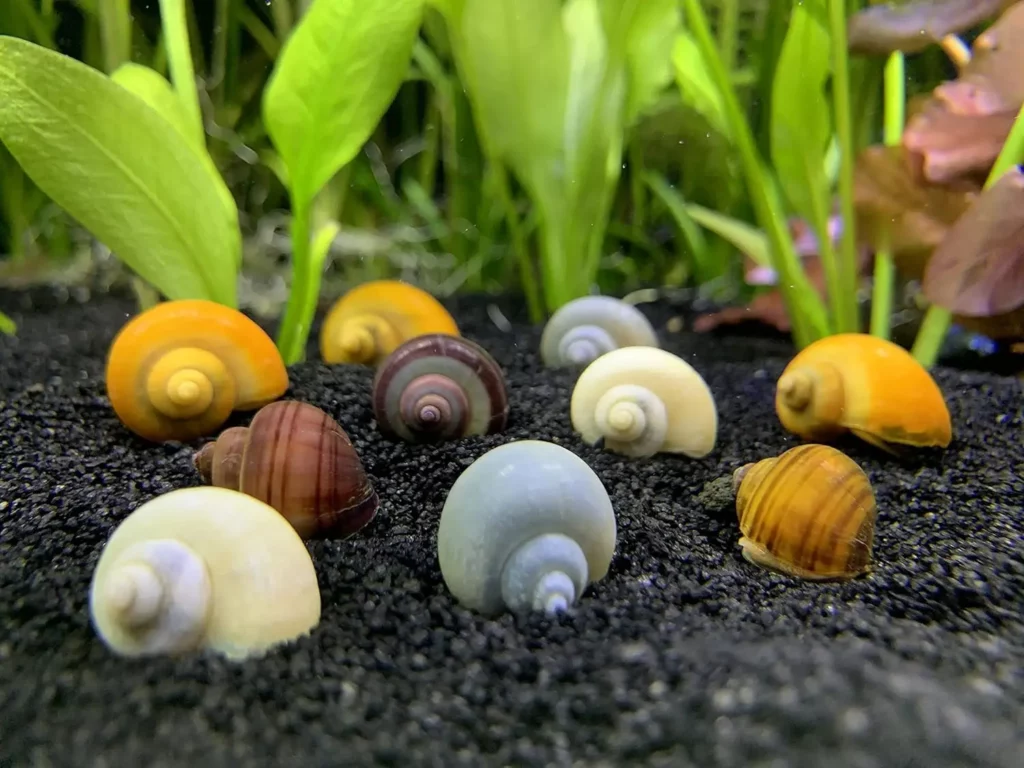
Mystery snails are crossbreeds between different species of Apple snails and as such share the same reproductive habits. Usually, I’d find a clutch of Mystery snail eggs adhered to my aquarium’s glass or rim, above the water surface.
The eggs will be packed in a sack and will look like small balls of shotgun shells but will be yellow or pink in color.
Anyway, after the clutch has been laid you have two options:
- Help the eggs to hatch;
- Get rid of them.
Hatching and taking care of the water snail babies is not difficult at all, but you’ll need to know what to expect.
That being said, let me show you what to do with your new Mystery snail eggs and how to handle the situation properly.
What to Do With a Clutch of Mystery Snail Eggs?
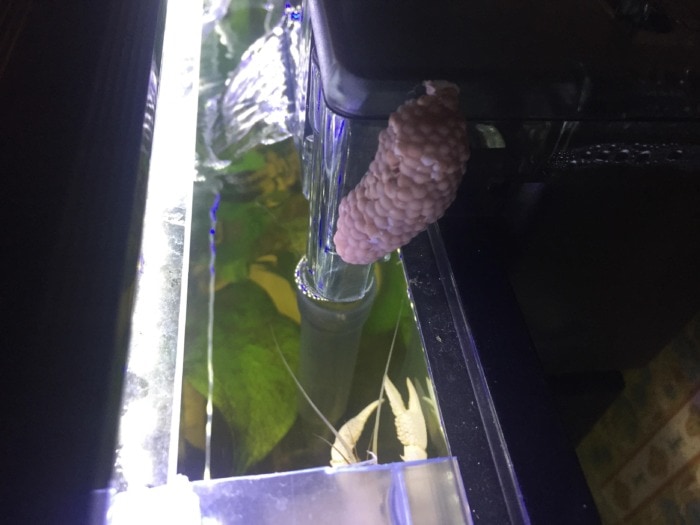
Before I move on I need to prepare you for what to expect if you decide to hatch the clutch of Mystery snail eggs:
- On average, a single clutch of eggs can produce between 20 and 40 healthy adult snails;
- Your Mystery snails will likely lay multiple clutches;
- You’ll likely need to set up a separate grow-out tank if you decide to keep the babies;
- You’ll need to re-home or sell the young snails if you don’t have the means to look after them.
If you feel comfortable with these consequences you can move forward with taking care of the eggs.
Author’s note: A female Mystery snail can lay eggs weekly for up to 4 and a half months. Being part of the Apple snail family, the female can store fertile sperm for up to 140 days, even without a mate present, in which period she deploys batches of fertilized eggs.
Moreover, Apple snails and Mystery snails in particular may lay unfertilized eggs too. A single specimen will lay one clutch of eggs per 7 to 10 days.
Following these thoughts, my somewhat bitter experience shows that trying to hatch too many egg clutches at once may crash the Nitrogen Cycle in your aquariums. This happens because the many snails and eggshells will produce copious amounts of waste and the beneficial bacteria in the tank won’t be able to keep up.
Even seasoned Mystery snail breeders dispose of the majority of clutches.
So what I do is I sometimes try to hatch a clutch or two and dispose of the remaining ones, as I’m not a full-time snail breeder.
I end up with, maybe, 30 to 40 healthy adult snails.
At this point, you could either mail them to interested members of your community or sell them online.
Usually, your local fish store would also take the snails when they approach about an inch in body length.
Mystery snails are rapid growers in the early stages of their life.
How to Tell Whether the Eggs Are Fertilized?
If you decide to hatch your Mystery snail’s eggs then you’d want to make sure the clutch is fertilized first.
It’s important to do so before investing time and energy in preparation for the hatching process.
To check if the eggs of your Mystery snail are fertilized look whether they go through the following stages:
- In the first 24 to 48 hours, the eggs are pale pink and very soft to the touch;
- During the next week, they harden and darken in color, becoming a garnet brown;
- They remain like this for the following 2 weeks;
- When the eggs are ready to hatch they will become somewhat slimy with a dark grey coloration and an even darker center. Some will appear as if they have small bubbles of air inside.
To help you understand I’ve illustrated the stages fertilized Mystery eggs go through:
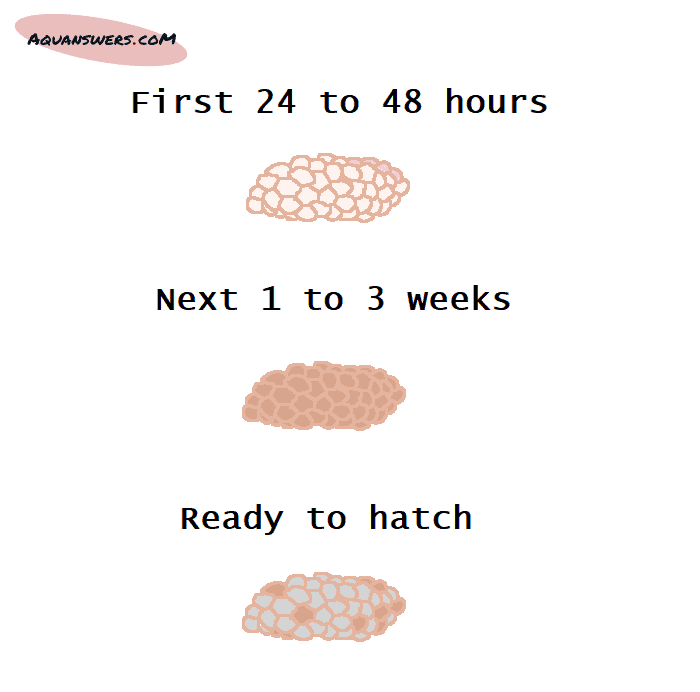
It takes between 10 days and 4 weeks for fertilized eggs to hatch.
On average, in most tropical aquariums the eggs will hatch on the third week. Higher water temperatures speed up the hatching process.
Unfertilized Mystery snail eggs will not change color and will remain pink beyond the first week.
If the clutch you’re monitoring does not change color then it’s safe to dispose of it. You can simply throw the unfertilized clutch of eggs in the trash can.
Don’t worry – unfertilized Mystery snail eggs are not technically dead because there was never something alive in them in the first place.
I’m saying this because some of you may feel guilty throwing them away.
So to recap – you won’t be able to tell whether the eggs will spawn babies before the end of the first week of their appearance.
If unfavorable conditions for the hatching set in place while the eggs are maturing they can die.
A dead Mystery snail egg becomes white and feels brittle to the touch. It’s essentially dried out.
You will inevitably see some dead eggs even if your hatching process is perfect, so don’t stress about it – that’s how nature works.
Anyhow, if you’ve done everything right and the eggs were fertilized in the first place, you will eventually see baby snails.
How to hatch the eggs of a Mystery snail?
The eggs of a Mystery snail need three conditions to thrive and hatch:
- High air humidity;
- Temperatures of between 76 and 82 °F (roughly 24.5 to 28 °C);
- Remaining above the water level.
If you take special care to ensure these conditions are met you will improve the hatching success of the snail babies.
Keeping the humidity and temperature in check is easy. However, you should also make sure that the eggs stay above the water line until they are ready to hatch.
Though they have both gills and lungs, Mystery snails breathe atmospheric air. For this reason, their clutches of unhatched eggs must remain above the water surface at all times.
If an egg clutch falls in the water and remains underwater for some time, the embryos will not come into fruition because they will drown.
Whatever happens do not fill the tank with enough water to cover the clutch.
On that note, if your Mystery snail lays eggs on the underside of the tank’s lid – it probably deemed that your tank is overfilled with water. In that case, don’t try to lower the water line, just leave the clutch as it is.
Typically, the females will try to position the eggs about 4 inches above the water line.
That being said, here are two ways to hatch the eggs of your Mystery snail:
- Leave the eggs as they are and make sure they’re moist. This hatching method requires very little maintenance, but has a reduced survival rate;
- Set up an egg incubator with a breeding box. This is a hands-on approach but ensures the best results.
Both approaches are beginner-friendly.
Let me explain each of these hatching methods in detail:
1. Leave the snail eggs as they are and keep them moist.
If you simply leave the clutch as it is, its hatching success will be lower.
For this method to work your tank needs to have a tight lid and you should see condensation forming.
Condensation is a good sign that there would be enough humidity to keep the eggs healthy.
You could mist them with aquarium water manually if you deem fit, just make sure they’re moist and not super wet.
Anyway, the Mystery snail hatchlings will emerge and drop directly in the tank.
When the eggs turn dark grey and ripples start to appear it means that they’re ripe.
You could gently crumble the clutch with your fingers to let the remaining babies in the water. You may lose one or two in the process but you’ll lose more if you don’t do it.
Anyhow, to improve the survival rate of the baby snails the rest of the livestock in your aquarium should be hatchling-friendly.
There are species of fish that will eat mature freshwater snails at all times, but when it comes to snail babies, the list of potential predators expands.
Any fish that is omnivorous or carnivorous will likely try to eat a newly-hatched Mystery snail if it fits its mouth.
For example, Betta fish eat small invertebrates and are a potential threat.
If your tank is not baby snail-safe then this method is not for you and you should look into the next one.
However, you could also leave the babies to hatch in the tank and become a potential snack if you’re doing it to supplement a community tank with predatory fish.
2. Set up an egg incubator with a fish breeding box.
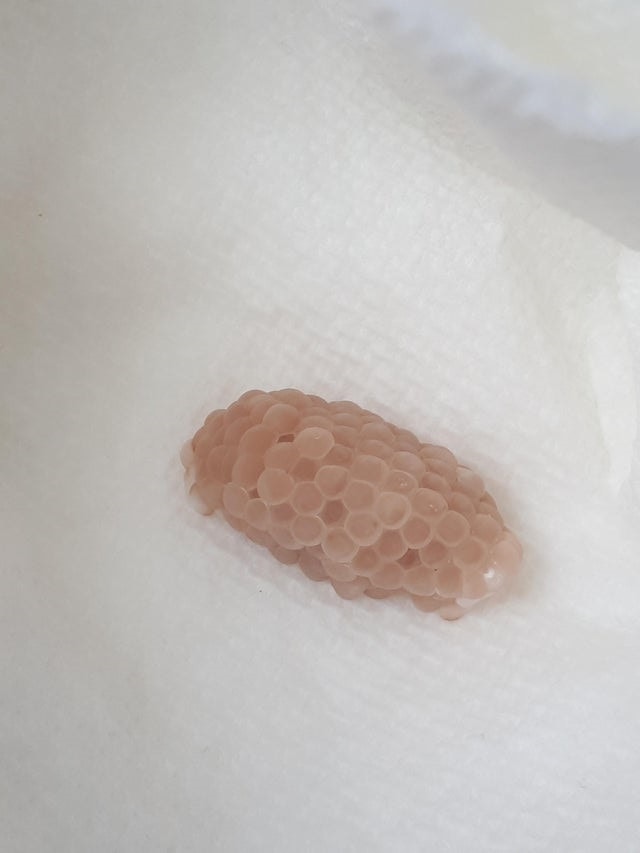
With this method, you’ll separate the eggs from potential predators in the tank while providing optimal hatching conditions.
The egg incubator method is ideal for people who keep fish alongside Mystery snails.
It is also convenient if you don’t have the means to set up a separate tank.
In the latter case, you must be confident that you’ll be able to rehome the Mystery snails once they outgrow the breeding box.
Anyway, some snail breeders advocate a form of DIY incubator that basically consists of a plastic box with holes in the lid, and a damp cloth or paper towel.
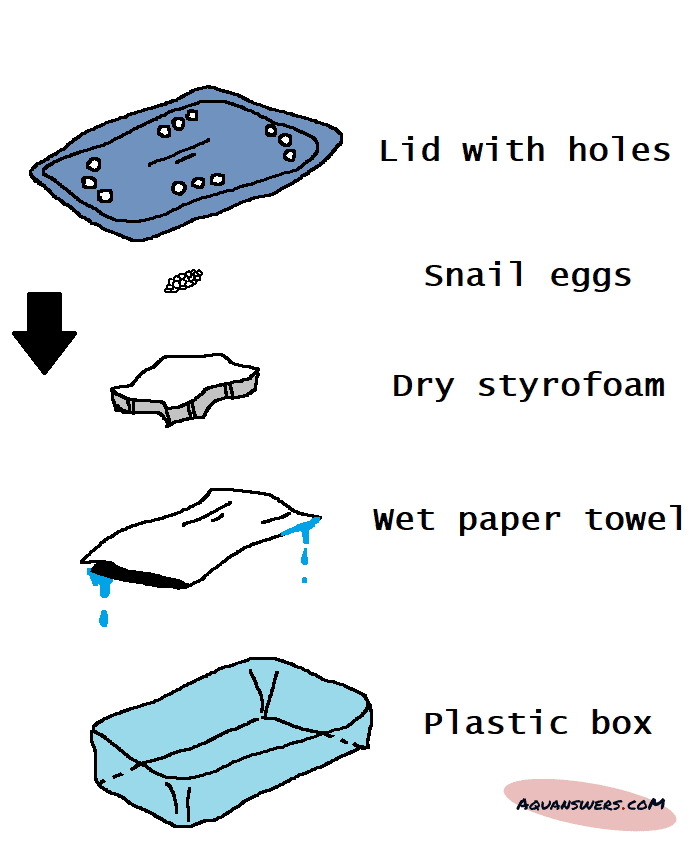
You simply put the eggs on a piece of dry styrofoam which sits on the damp cloth inside the plastic box. You then leave them inside and let the box float in the aquarium for acclimatization.
This type of incubator is perfectly viable for hatching the snail eggs, but I personally don’t like it for a couple of reasons.
The DIY egg box incubator has a few disadvantages:
- You need to perform daily maintenance of interchanging the paper towels and moisturizing the eggs if needed;
- The floating box casts shadows in a planted tank, blocking light from your aquarium lighting that goes to the aquatic plants underneath.
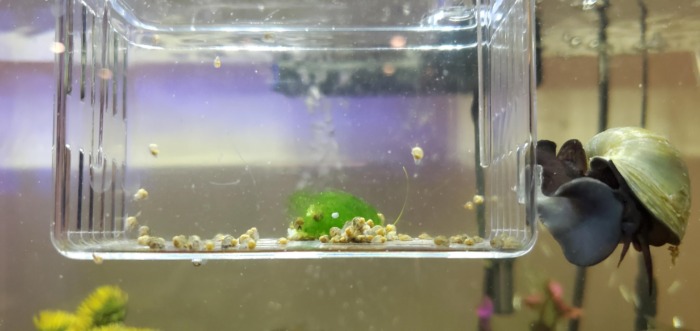
What I prefer instead is using one of the cheap fish breeding boxes available at any fish store or online. The one I’ve chosen in the link has the ideal properties for the job.
Follow these steps to hatch Mystery snails within a breeding box:
- Use the suction cups of your breeding box to fix it on the tank’s glass. Allow some aquarium water to enter from the bottom. You could also let the breeding box float in your aquarium.
- Remove the clutch of eggs by gently twisting it, until it comes off. No need to use razor blades or other tools for this. Put the eggs on a paper towel.
- Cut out a piece of styrofoam so that it fits in the breeding box and put it inside. The styrofoam should float on the water inside the box.
- Carefully place the clutch of snail eggs on the piece of styrofoam.
- Close the lid of the breeding box.
And you’re done. After completing these steps you just need to wait for the eggs to hatch.
The water and the tank’s temperature will keep the eggs moist and warm.
When the hatchlings emerge they won’t fall through the holes of the box and it will be easier for them to find food and crawl up for air.
Author’s note: If you have an open-lid tank that sits in a well-ventilated place you may want to cover the top of your hatchery with plastic wrap to contain the humidity inside. Also, make sure to poke a couple of holes in the foil to let air in.
How to take proper care of baby Mystery snails after the hatching?
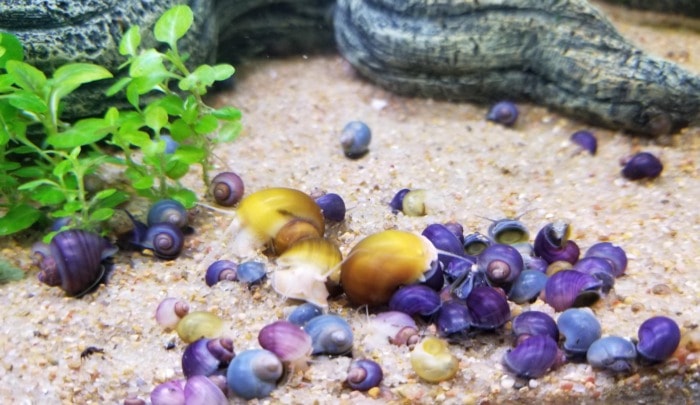
Taking care of Mystery snail babies is not particularly difficult and is almost the same as looking after adult snails.
The one difference here is that the baby snails would need an additional source of Calcium to strengthen their young shells.
The easiest way to provide them with that is to add a piece of cuttlebone in their tank or breeding box.
The cuttlebone is a source of Calcium and Mystery snails like to munch on one.
It’s usually sold under the bird pet section of websites, so here’s a quick link to the right stuff on Amazon. These may sometimes arrive broken but that’s irrelevant for what you’re about to use them.
Anyway, aside from that the baby Mystery snails are omnivores, and feeding them only algae wafers won’t be enough:
You’ll need to provide the hatchlings with blanched vegetables.
I personally use blanched Zucchini or cucumbers, green beans, peas, and broccoli.
Feeding meaty foods is equally important for keeping your snail babies healthy. Offer meat-based pellets such as shrimp pellets or the like.
It’s also recommended to leave the crumbled eggshells for the babies to feed on them at first. These eggshells are nutritious and give the hatchlings a kick-start.
After the eggshells have depleted continue feeding the Mystery snail babies daily as they will grow really fast when young.
You can expect all of them to reach 0.75 inches (1.9 cm) in just 2 months.
At that point, you can initiate your plan for rehoming or deploying them in your tanks.

How to Dispose of Your Mystery Snail’s Unhatched Eggs That You Don’t Want to Keep?
There are two methods for Mystery snail egg disposal that I recommend using.
I believe both are as humane as possible.
One is dependent on the tank you run and is basically re-introducing the eggs in the circle of life.
Right after you notice the clutches you could crumble them back in the water to become fish food.
If you keep omnivorous or carnivorous fish in your aquarium they’ll happily take the treat.
Just don’t overdo it with multiple egg clutches or you risk crashing the tank.
The other method that I use more often is to simply freeze the eggs and throw them in the trash later.
I wait 48 hours for the clutch to stiffen and remove it from the glass with a gentle twisting motion.
I then put it in a ziplock bag and throw it in the freezer for a couple of days.
Freezing supposedly neutralizes the eggs before anything inside has the time to develop and “feel” anything.
Anyway, the only real way to control the influx of eggs laid by Mystery snails is to only keep male specimens.
However, telling males from females is extremely difficult. Getting rid of the clutches is way easier.
It’s a myth that you could simply raise the water level in your aquarium and the Mystery snails won’t lay.
The snail will find its way to the lid of the tank and lay its eggs upside-down anyway.
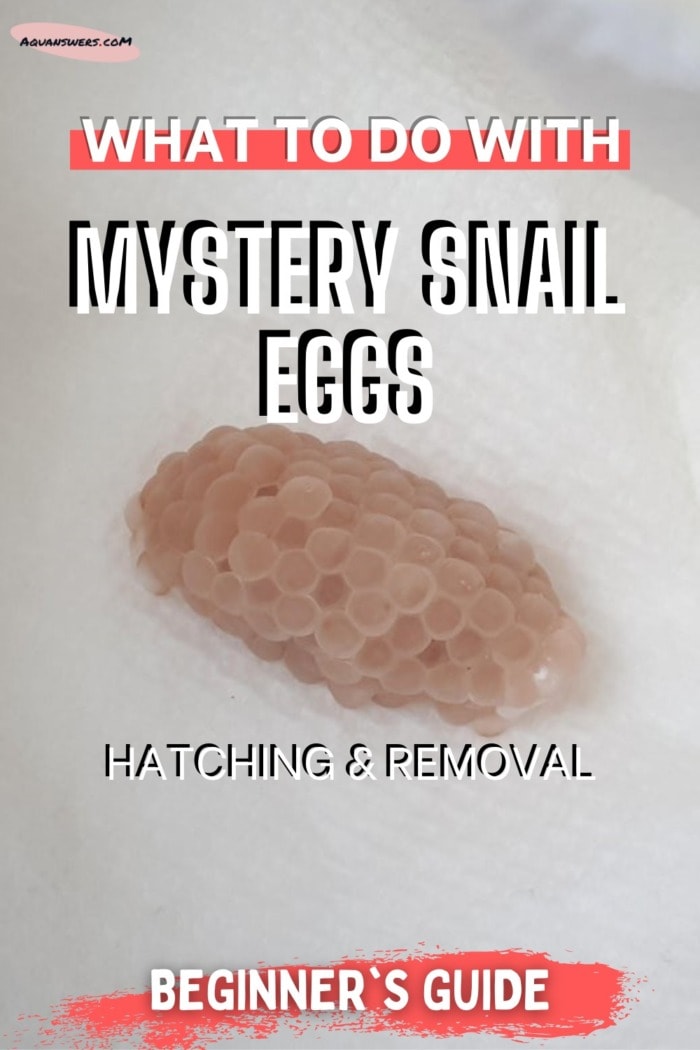
So what did you decide to do with yours? Share your story in the comments below!

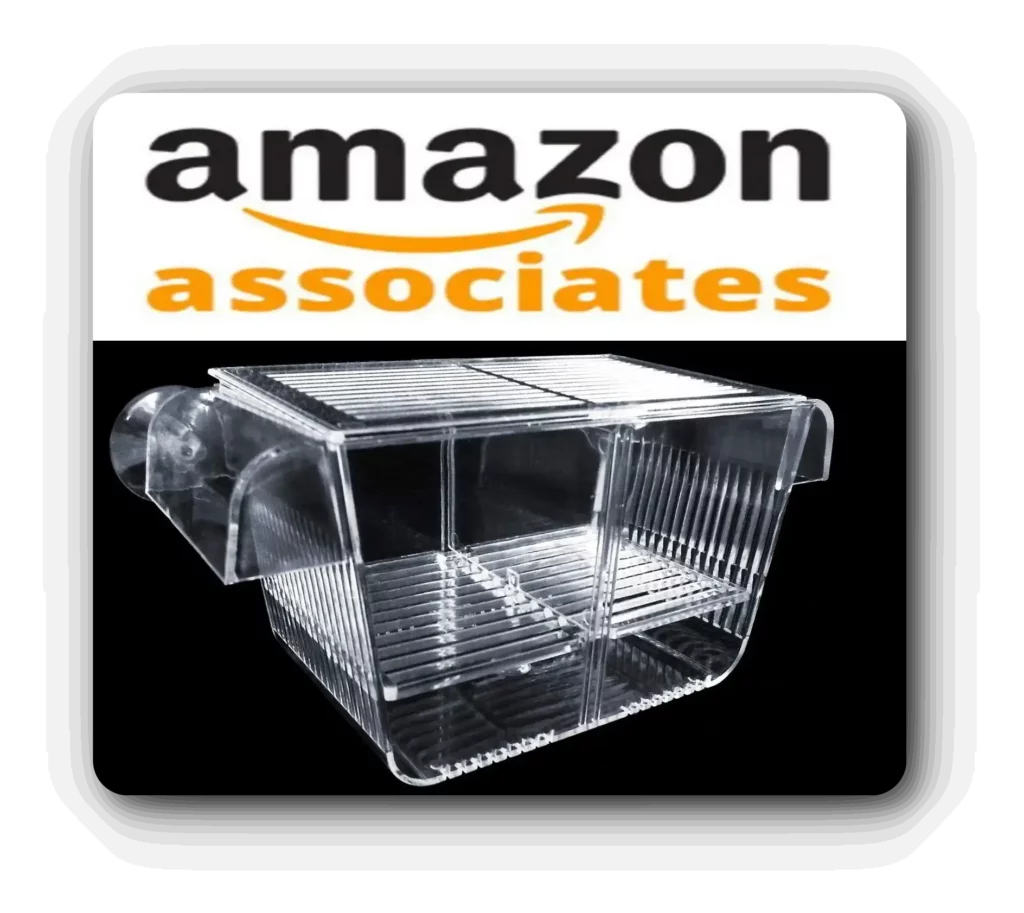
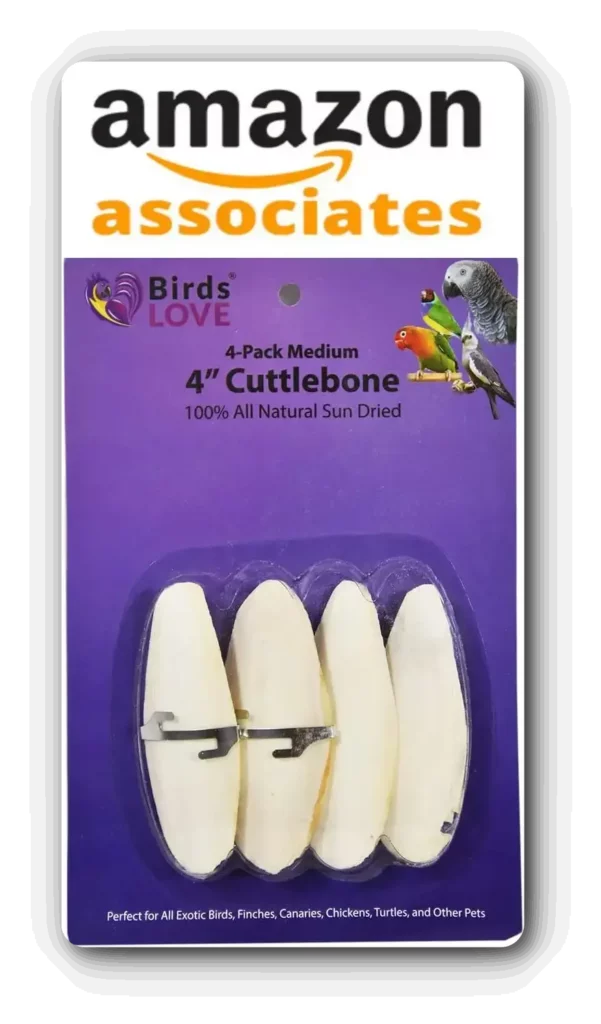









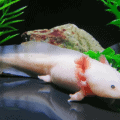
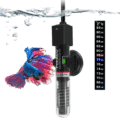
I’ll confirm what you said about they’re just going to lay their eggs on the cover anyway. Mine have done that twice now.
I’ve gotten rid of more than half of each clutch and am hoping for 3-5 viable snails to hatch out of the remaining parts. However, I didn’t know about fertilized vs unfertilized eggs until reading this post 10 minutes ago. I’m suuuuuuper new to snails. Thanks for the info!
This is what I have:
2 Mystery
4 Nerite
1 Japanese Trapdoor that just had 10 babies LOL
I was happy when I spotted a clutch of mystery snail eggs on my aquarium glass. The next day, another, and another and now five clutches. Help me.
I have crushed and disposed the eggs within a day or two of them being there, I have dealt with 2 clutches in the past 9-10 days, one being today. This was VERY informative about the eggs.
I have two mystery snails in my tank, and I noticed them breeding around a month or two ago. So I have been on high alert for eggs. I have a small (10gal) tank, so I cannot deal with even more snails. They produce way too much waste, my shrimp couldn’t handle that.
Could it be possible that the glass on the out side of tank cold be colder than the tank water affecting the eggs not to hatch? Greg
Nice article, Momchil!
My husband, a biology teacher, who has raised snails in his tanks for decades, offers one correction regarding your statement, “the only real way to control the influx of eggs laid by Mystery snails is to only keep male specimens.” Actually, all snails are hermaphrodites, producing both sperm and eggs. One snail slowly exchanges sperm with another.
Hello Susan,
Thanks for being a reader and thank you to your husband for his remarks. As far I understood from my research Mystery Snails are one of the few species that are not hermaphrodites (having both male and female reproductive organs) but can sometimes change sex, depending on the environment (having either male or female reproductive organs).
Regards
@Susan Wrong. Mystery snails are male or female. They can NOT change sex, no matter the situation. It’s called gonochoric. I bet your hubby knows that word.
A little hostile you think? we are talking about snails here, chill
I have had two clutches hatch and did absolutely nothing to them – just completely ignored them. Nature did its thing and we have a lot of snail babies, and two new clutches.
I recently used the “freezer” method to dispose of my snails first clutch (because I physically don’t have the space for any more between my two tanks.)
It went well but I fear that the mother was in distress when she returned to the spot the eggs were laid. I just found a second cluster of eggs & I’m curious what to do with them this time & in the future.
Does anyone have experience with this and do you know about the potential effects on my parent snails if I continue to get rid of the clusters long term?
Any info helps.
Thanks!
– Danny O.
okay let me know what to do here. my clutch was produced on October 15, 2021 and i have followed the above instructions. the clutch has gone through the different phases that you mentions here. but as of today it still has not opened up. can someone give some ideas here. thanks
My snails laid a clutch a week after I got them..a large clutch on the side of the tank and a small one on the roof of the tank. I only have 2 blue mystery snails so I’m not sure if it was both snails laying or just 1. It’s been almost a week and it looks like a pinkish melon color. Going to let nature run it’s course! I’m excited about it though!
Hi, it’s been a week and few days since my female laid eggs, the hatch is still pink, so how long does it take to hatch? I keep water at 75/76 and they are floating in a container with several poked holes. They are starting to look dried out, so we spray them but not soak them everyday. If I turn up heat, will it make process go up better because we leave for a cruise on 11th 😬
Hello Melissa,
I have no experience with that so I can’t give a reliable answer, unfortunately.
You’re doing good by spraying them, humidity is a key factor, IMO.